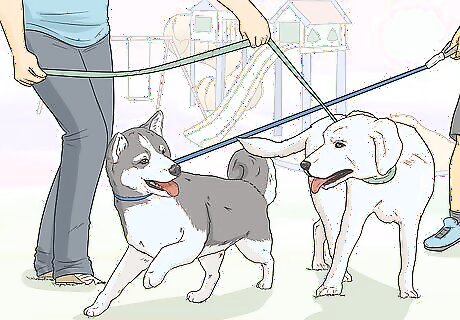
views
X
Trustworthy Source
Science Direct
Online archive of peer-reviewed research on scientific, technical and medical topics
Go to source
Training a seizure alert dog is different from training other service animals, as it largely comes down to bonding and knowing your dog well. However, you might prefer to get a dog from an agency that trains the dog for you.
Choosing a Dog

Understand that alerting to seizures is an innate ability only some dogs have. While some dogs can detect seizures before they happen, you can't train a dog to have this ability. However, you can encourage a dog that naturally has this ability to be an alert dog. Unfortunately, you won't know if your dog is able to alert to seizures until you bond with it. If your dog can't alert, it can still be a great companion and can be trained to assist you in other ways. For instance, you might train it to get you help if you're having a seizure.

Get a puppy to ensure the best chances for success. While you may be able to train an older dog, a puppy will be the best learner. Additionally, they’re typically more open to bonding with a new owner. If possible, choose a puppy as your seizure alert dog. Look for a litter of puppies at the local animal shelter or online through breeders in your area. Don’t buy a pup from a pet store, however, as they typically aren’t socialized well when they’re babies. You want a dog that’s sociable.Variation: If you already feel bonded with a dog, they may be the perfect seizure alert dog for you. Having a strong bond is what’s most important.

Look for a dog that is calm and gentle in its demeanor. Your seizure alert dog needs to feel comfortable in all situations and must be able to remain calm when you’re having a seizure. Talk to the dog’s breeder or handlers to see how it behaves. Additionally, ask how it relates to people and other dogs. Limit your options to dogs that are friendly. Notice how often the dog barks. You want a dog that barks infrequently so you’ll know that something is wrong when you hear it barking. Avoid a dog that lunges, jumps on people, or barks at other dogs. It's normal for puppies to be more energetic than an older dog. However, you don't want an aggressive dog.

Spend time with the dog to see if it likes you. Your dog can’t be a good seizure alert dog for you if it doesn’t bond with you. Play with the dogs you’re considering training to see how they respond to you. Pick a dog that comes to you, enjoys your pets, and gives you lots of licks. Seizure alert dogs are only accurate if they know their owner well enough to detect that something about them has changed. Your dog needs to be a good match for you.

Pick a mid-sized breed if you want help with other tasks. Your dog can assist with some tasks, like getting your medication or turning off lights, but it needs to be big enough. However, a large dog might be hard for you to handle, so it’s best to stick with mid-sized breeds. These include breeds like golden retrievers, Labrador retrievers, German shepherds, border collies, and cocker spaniels. Small dogs can be trained as seizure alert dogs. However, they may not be able to help you with other tasks due to their size.Did You Know? Dogs that provide more assistance than alerting you to a seizure are called seizure response dogs.
Encouraging Your Dog to Alert

Teach your dog obedience skills so they respond to you. Before your dog can be a service dog, it needs to know how to behave. Train it to do basic skills like heel, come, stay, wait, listen, and fetch. Schedule training sessions in 5-15 minute blocks so your dog doesn’t get overwhelmed. When they do the correct behavior, give them a treat. Treats can be praise, food, or a favorite toy. If you can, enroll your dog in an obedience training program so they get the best training possible. Typically, seizure alert dogs have about 2 years of obedience training if they’ve gone through a professional training program.

Socialize your dog so it’s comfortable around other people and pets. Your dog needs to get used to being around other people and animals, as it’ll be with you all the time. After it’s 16 weeks old, take your dog everywhere with you. Instruct your dog to stay at your side, and reward it when it remains calm while stimulated. Rewards might include pets or a small dog treat, like a milk bone.

Keep your dog with you at all times. Seizure alert dogs are a service dog, so you have a right to take them anywhere. Legally, you don’t need to get your dog professional training for it to be a service dog. As long as your dog is obedient, it’s okay to take it everywhere with you. Get a service dog vest for your dog from a pet store or online so it can stay at your side. Your service dog is allowed everywhere, even if there are “no pets” signs. Additionally, you do not have to provide proof of your disability, though some people may ask about it.

Watch your dog so you can learn its alert signs. Your dog will decide how it will alert you to an upcoming seizure. Pay attention to your dog’s behavior so you can recognize the signs that it's trying to alert you. Your dog predicts a seizure by noticing something is different about you. In response, it will do 1 of the following behaviors: Barking Pawing at the ground Walking in circles Staring at you while whiningWarning: There's no guarantee that your dog will alert you about an upcoming seizure. It's possible that your dog won't have this ability.

Get into a safe position if you think your dog is alerting. When you first get your dog, it may be hard to tell if it's alerting to a seizure or not. Regardless, treat every possible alerting behavior as a sign of an oncoming seizure. Tell someone you may need medical attention and make yourself comfortable and secure. Your dog may alert you up to 45 minutes before the seizure, so monitor yourself for at least 45 minutes. If you don’t have a seizure, you’ll know that your dog wasn’t alerting.Tip: Don’t play with your dog or give them pets while you’re responding to a possible alert. It’s okay for your dog to place its head in your lap, but rewarding it may teach the dog to alert when it wants attention.

Reward your dog if it alerts you to a seizure. If your dog successfully predicts a seizure, offer it a high-value treat and lots of praise to encourage it to continue that behavior. Choose a treat that you know your dog will love. Over time, your pup will learn that it gets rewarded for alerting you prior to a seizure. For instance, you might carry dog beef jerky at all times so you can reward your dog after it correctly alerts. Don’t give special treats to your dog when it incorrectly predicts a seizure. Otherwise, it won’t understand which behavior you want it to do. Your dog may not be able to alert to seizures, so don't punish it for failing to warn you.

Don’t scold your dog for alerting behavior because it may stop alerting. Sometimes your dog may do alerting behaviors for other reasons, such as barking at the doorbell. Similarly, it may take you a while to recognize how your dog alerts. Keep a positive or neutral attitude toward alerting behaviors. Otherwise, your dog may learn that these behaviors are unwanted, which will make it fail to alert. For example, let’s say your dog is scratching the floor and whining. You’ll likely worry that the floor will get damaged, which may make you scold the dog. However, your dog could be trying to warn you about a seizure. Similarly, if you know your dog barks to alert, don’t scold your dog when it barks for other reasons. Instead, acknowledge the bark and address what it’s barking at, such as the doorbell.
Acquiring a Professionally Trained Dog

Research agencies that train seizure alert dogs. Review each agency’s website, read reviews from prior clients, and look for news articles about possible complaints. Then, talk to the agency you’re considering. Ask them about their success rate and what types of training they offer the dogs. Typically, professionally trained seizure dogs cost $10,000-$25,000. These fees go directly to the cost of training.

Ask agencies if they provide donated seizure alert dogs. Since seizure dogs are so expensive, some agencies allow donors to sponsor a dog. You may be able to get one of these dogs for free. Talk to the agencies you’re considering and ask if they offer donated dogs. If they do, request that you be put on a waiting list.Warning: Seizure alert dogs are typically hard to acquire, so you may be placed on a wait list.

Raise money to pay for your dog if you can’t afford one. Paying for a seizure alert dog can be difficult, and they often aren’t covered by insurance. However, you may have people in your life who will be happy to help you pay for your dog. Start an online fundraiser or reach out to friends and family to ask about donations. For instance, you might use a site like Go Fund Me to raise money for your dog. As another option, host a fundraising event like a kickball tournament or a barbecue. Your friends and loved ones will likely be happy to help you get a dog to help you.

Expect your dog to live with its trainer for about 1-2 years. Seizure dogs get a ton of training before they come to you. Your dog will spend about 2 years learning to be obedient, then the training agency will evaluate it to see if it’s a good candidate to alert for seizures. After about 2 years, you’ll be able to take your dog home. A benefit of a professionally trained dog is that it will do extra tasks. In many cases, a seizure dog that’s been professionally trained will also respond to your seizures. They may keep you safe, comfort you, get your medication, or get you help. Ask your trainer what your dog is trained to do.

Bond with your dog after you receive it. It’s essential that you have a close bond with your seizure alert dog. Otherwise, it won’t be able to detect your seizures. When you bring your dog home, set aside time for you to bond with it. Spend every moment with your dog so it learns that you’re its human. Remember that you can take your dog anywhere with you, as it’s a trained service dog.

Be aware that no trainer can promise that your dog will alert. Unfortunately, alerting to seizures is an innate skill that only some dogs possess. No amount of training can teach a dog without this innate quality to do it. However, your seizure dog can still help you by responding to a seizure. Just set reasonable expectations for what your dog can do for you.



















Comments
0 comment